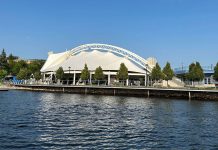Kenora – News – There is still time in the process for members of the public to participate in the planning for the future of the walleye fishery on Lake of the Woods.
Lake of the Woods is the second largest inland waterbody in Ontario (385,000 ha). It is shared with the Province of Manitoba and the State of Minnesota. Ontario waters comprise 245,000 ha (64%) of the total surface area. Lake of the Woods supports the most economically valuable inland recreational fishery in Ontario, with an estimated annual angler expenditure of $111.4 million. While this value includes recreational fishing for all species, studies show walleye is the species most sought by anglers on Lake of the Woods.
The Ontario portion of Lake of the Woods is home to over 6,000 cottages and other seasonal properties as well as more than sixty tourism businesses, including outfitters, main base lodges, campgrounds and guiding businesses. The tourism industry employs roughly 38% of the workforce in the City of Kenora. In addition, both commercial and subsistence fishing play a significant role in the lives of Indigenous people on and near Lake of the Woods, contributing to the dietary, social, cultural and economic needs of numerous First Nations and Metis communities.
The MNRF monitoring data on Lake of the Woods indicates that the walleye population is vulnerable to continued high-levels of harvest to the point where the current harvest poses a risk to the quality of the walleye fishery. Specifically, there are three ecological issues of concern:
- harvest rates are high and impact the population’s ability to buffer against pressures such as invasive species, increased harvest and climate change
- observed biomass of walleye is below the benchmark biomass
- mortality rates are high and there are few old walleye in the population
Taken together, these issues suggest the walleye fishery is at risk in the long-term. The ability of the walleye population to buffer itself against unforeseen pressures in the future, such as poor reproductive years, increased fishing pressure or severe climate events, is low. At the same time, MNRF recognizes the importance of the walleye fishery to the social and economic wellbeing of the communities in the Lake of the Woods area and is committed to balancing conservation and socio-economic considerations.
The MNRF has partnered with several local Indigenous communities, tourism operators, municipal government and recreational users to form the Lake of the Woods Fisheries Advisory Council. Since January 2021, this group has been meeting to develop this Lake of the Woods Draft Recreational Walleye Plan to improve the status of the walleye population while recognizing the social and economic importance of the fishery, consistent with the directions of Ontario’s Provincial Fish Strategy (MNRF 2015).
The ecological and socio-economic objectives of the management plan are:
- reduce walleye harvest associated with the recreational fishery
- increase biomass of larger/older walleye
- treat all recreational anglers for walleye equally
- recognize the impact of regulatory changes on the local tourism industry
- provide additional angling opportunities for other species, consistent with the goals of Ontario’s Provincial Fish Strategy
Actions associated with the fifth objective will be deferred to future planning exercises.
Currently, the recreational fishing regulations for Lake of the Woods are:
Season: January 1 to April 14 and third Saturday in May to December 31
Limits (Ontario and Canadian Residents): Sport 4 and Conservation 2; not more than 1 greater than 46 cm.
Limits (Non-residents): Daily Catch-and-retain limit – Sport 2 and Conservation 2; not more than 1 greater than 46 cm.
Possession limit – Sport 4 and Conservation 2; not more than 1 greater than 46 cm.
In order to address the first four management objectives, MNRF is proposing the following changes to recreational fishing regulations for walleye:
Preferred Option
Season: January 1 to April 14 and third Saturday in May to December 31 (unchanged)
Limits (All anglers): Daily Catch-and-Retain Limit – Sport 2; must be less than 43 cm or greater than 70 cm and not more than 1 greater than 70 cm
Conservation 1; must be less than 43 cm
Possession limit – Sport 4; must be less than 43 cm or greater than 70 cm and not more than 1 greater than 70 cm
Conservation 2; must be less than 43 cm
Alternate Option
Season: January 1 to April 14 and third Saturday in May to December 31 (unchanged)
Limits (All anglers):
Daily Catch-and-Retain Limit – Sport 2; must between 35 cm and 43 cm or greater than 70 cm and not more than 1 greater than 70 cm
Conservation 1; must between 35 cm and 43 cm
Possession limit – Sport 4; must between 35 cm and 43 cm or greater than 70 cm and not more than 1 greater than 70 cm
Conservation 2; must between 35 cm and 43 cm
Public engagement
The ministry conducted consultation, including on the draft plan proposals, during three virtual sessions hosted in March 2022. Comments were generally supportive of the proposals.
The Lake of the Woods Draft Recreational Walleye Plan will be available on the Environmental Registry for Ontario for a comment period of 60 days. Public information centers will be hosted in Kenora and Nestor Falls in early November 2022. In addition, information will be available through social media.
Sixteen potentially affected Indigenous communities have been contacted directly for comment.
Following consultation, a final version of the Lake of the Woods Draft Recreational Walleye Plan will be posted on the Environmental Registry for Ontario, along with a decision notice.
Regulatory impact analysis
- the anticipated environmental consequences of the proposal are positive. The proposal is expected to reduce annual angler harvest of walleye, which in turn will improve the available biomass of walleye and the age structure of the population.
- in the long term, the social consequences are expected to be positive, as the walleye population and angling improves
- the effects on the tourism industry were a key consideration in developing the regulatory proposal and as such the anticipated economic consequences of the proposal are neutral
- there are no administrative costs to industry or individuals associated with changes in recreational fishing regulations








